Topic: Succession Change Of Ecosystems Over Time
Succession Change Of Ecosystems Over Time
Which process is represented in the diagram below?

(1) energy flow
(2) biological evolution
(3) cellular communication
(4) ecological succession
The diagram represents the changes in an area over time.

This series of changes in the area over hundreds of years is known as
(1) evolution
(2) feedback
(3) ecological succession
(4) direct harvesting
An ecological process is represented below.
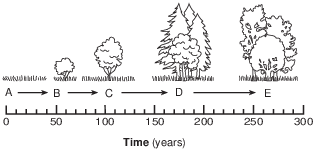
Which statement describes an event in this process?
(1) Community B modifies the environment, making it suitable for community C.
(2) Community D modifies the environment, making it suitable for community C.
(3) Community E will develop into community A, if the environment remains stable.
(4) Community A organisms will develop directly into community D organisms.
Farmland abandoned in 1899 was observed to have significant changes in plant species over a 50-year period. The changes are shown in the chart below.
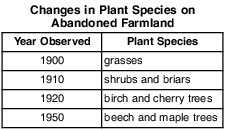
A forest fire burned all the trees on the land in 1955. Assuming no human interference, climate changes, or natural disasters, the plant species you would expect to see on this land in 2010 would most likely be
(1) grasses
(2) shrubs and briars
(3) birch and cherry trees
(4) beech and maple trees
Which situation is most likely to lead to ecological succession?
(1) The fish populations in a large lake remain the same for many years.
(2) Hunters are allowed to hunt wolves, with no limits, for one season.
(3) The amount of industrialization increased in an area, resulting in the increased burning of fossil fuels.
(4) A farmer who has planted corn for many years retires, and the field is left abandoned.
Which statement describes an event that would most severely disrupt the process of ecological succession in an area?
(1) The season changes from spring into summer.
(2) Native plants are planted in an abandoned field.
(3) Plants and animals begin to colonize a newly formed volcanic island.
(4) A dam is built on a river to form a reservoir.
If the grass in the front yard of an abandoned house is not cut for several years, the yard may become overgrown with taller grasses, bushes, and shrubs. This is an example of the process of
(1) evolution
(2) homeostasis
(3) ecological succession
(4) direct harvesting
Over a long period of time, the stages represented in the diagram below were each present in a particular ecosystem.

After a forest fire, what is the most likely order in which these stages appeared?
(1) D → C → A → B
(2) B → D → C → A
(3) A → B → C → D
(4) B → C → D → A
In New York State, small farms that were abandoned many years ago have become hardwood forests. This is an example of
(1) local deforestation
(2) biotechnology
(3) ecological succession
(4) habitat loss
The diagram below represents different stages of an ecosystem over a period of time.
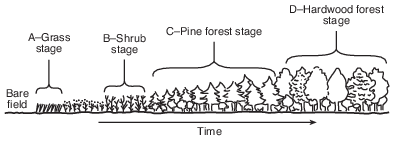
Which stage of the ecosystem has the greatest long-term stability?
(1) A
(2) B
(3) C
(4) D
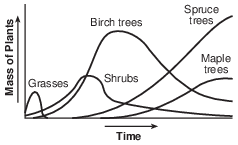
Based on the information provided in the graph, the process that is occurring is
(1) ecological succession
(2) biological evolution
(3) selective breeding
(4) genetic engineering
Shawangunk Grasslands National Wildlife Refuge has been developed from an abandoned airport to restore habitat for six species of birds that require an area rich in tall grasses. Workers must continually remove trees that are beginning to invade the area as a result of
(1) direct harvesting
(2) genetic engineering
(3) evolutionary change
(4) ecological succession
Nature Will Have to Clean Up Hawaii Molasses Leak That Killed Thousands of Fish
A massive spill of thick molasses has turned Honolulu Harbor into a watery wasteland where thousands of fish have been suffocated – a disaster that officials say Mother Nature will have to clean up.
“There’s nothing alive there at all,” diver Roger White told NBC affiliate KHNL after making a seven-minute video of dead sea life blanketing the bottom of the harbor.…
…“Unlike with an oil spill, it’s a sugar product so it will dissipate on its own,” Matson spokesman Jeff Hull told NBC News on Thursday. “There’s not an active cleanup.”
“The molasses is not toxic but it’s heavier than water so it’s spreading around on the sea floor, displacing the oxygen-rich water down there, and the fish are suffocating,” said Keith Korsmeyer, a professor of biology at Hawaii Pacific University.
The die-off also could lure predators like sharks, barracuda and eels to the harbor and neighboring Keehi Lagoon, experts warned.…
…Korsmeyer said marine life would probably repopulate the harbor, after the low- oxygen water moves out, but that could take months or even years.…
Source: http://www.nbcnews.com/news/other/nature-will-have-clean-
hawaii-molasses-leak-killed-thousands-fish-f8C11137030
Predict what will most likely happen to this ecosystem in 20 years if no other disasters occur. [1]
Allow 1 credit. Acceptable responses include, but are not limited to:
• — Marine life would repopulate the harbor.
• — The ecosystem would recover on its own.
• — The ecosystem might not recover due to the degree of destruction that occurred.
• — It would recover due to ecological succession/reach a climax community.
The data table summarizes the changes that occurred to farmland in the years immediately following its abandonment. The land is located in a very stable ecosystem. It was abandoned after years of overuse and weathering, which resulted in the depletion of soil nutrients.
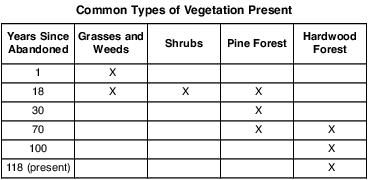
Assuming the ecosystem remains undisturbed, which type of vegetation would you expect to be most common in this area 200 years after it was first abandoned? Support your answer. [1]
Most common vegetation: ___________________________________________________
Allow 1 credit for hardwood forest and supporting the answer. Acceptable responses include, but
• are not limited to:
• — They make up the climax community and will remain the most common plant until the
• environment changes.
• — The hardwood forest will remain because it is the most stable.
• — They were the climax species because they replaced all the others and existed from year 70
• on.

Identify some of the key events associated with the change. In your answer, be sure to:
• identify one natural event that could cause the disruption indicated in the diagram [1]
• state what would most likely happen to the new stable ecosystem in future years if no further disruptions occur [1]
The student’s response to the bulleted items in the question need not appear in the following order.
• 15 Allow 1 credit for identifying one natural event that could cause the disruption indicated in the
• diagram. Acceptable responses include, but are not limited to:
• — fire
• — volcanic eruption
• — hurricane/flood
• — earthquake
• 16 Allow 1 credit for explaining what would most likely happen to the new stable ecosystem in future
• years if no further disruptions occur. Acceptable responses include, but are not limited to:
• — The new stable ecosystem would probably continue in the area.
• — It would probably remain unchanged for many years.
• — It will remain a stable ecosystem.
• — It would remain the same.
• — It becomes a climax community/grassy field.
